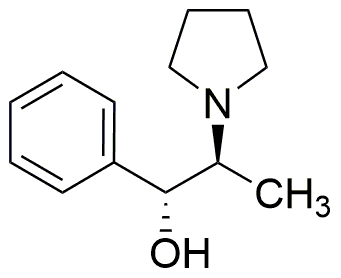(1R,2S)-1-Phenyl-2-(1-pyrrolidinyl)-1-propanol is widely utilized in research focused on:
- Pharmaceutical Development: This compound serves as a key intermediate in the synthesis of various pharmaceuticals, particularly in the development of analgesics and anti-anxiety medications, offering potential therapeutic benefits with fewer side effects.
- Neuroscience Research: It is used in studies related to neurotransmitter modulation, helping researchers understand brain function and the effects of certain drugs on mood and behavior.
- Chiral Synthesis: The compound's chiral nature makes it valuable in asymmetric synthesis, allowing chemists to create enantiomerically pure products, which are crucial in many drug formulations.
- Analytical Chemistry: It is employed as a standard reference material in chromatography and mass spectrometry, aiding in the accurate identification and quantification of related compounds in complex mixtures.
- Material Science: The compound can be explored for its potential applications in developing new materials, such as polymers with specific mechanical properties, enhancing product performance in various industries.
General Information
Properties
Safety and Regulations
Applications
(1R,2S)-1-Phenyl-2-(1-pyrrolidinyl)-1-propanol is widely utilized in research focused on:
- Pharmaceutical Development: This compound serves as a key intermediate in the synthesis of various pharmaceuticals, particularly in the development of analgesics and anti-anxiety medications, offering potential therapeutic benefits with fewer side effects.
- Neuroscience Research: It is used in studies related to neurotransmitter modulation, helping researchers understand brain function and the effects of certain drugs on mood and behavior.
- Chiral Synthesis: The compound's chiral nature makes it valuable in asymmetric synthesis, allowing chemists to create enantiomerically pure products, which are crucial in many drug formulations.
- Analytical Chemistry: It is employed as a standard reference material in chromatography and mass spectrometry, aiding in the accurate identification and quantification of related compounds in complex mixtures.
- Material Science: The compound can be explored for its potential applications in developing new materials, such as polymers with specific mechanical properties, enhancing product performance in various industries.
Documents
Safety Data Sheets (SDS)
The SDS provides comprehensive safety information on handling, storage, and disposal of the product.
Product Specification (PS)
The PS provides a comprehensive breakdown of the product’s properties, including chemical composition, physical state, purity, and storage requirements. It also details acceptable quality ranges and the product's intended applications.
Certificates of Analysis (COA)
Search for Certificates of Analysis (COA) by entering the products Lot Number. Lot and Batch Numbers can be found on a product’s label following the words ‘Lot’ or ‘Batch’.
*Catalog Number
*Lot Number
Certificates Of Origin (COO)
This COO confirms the country where the product was manufactured, and also details the materials and components used in it and whether it is derived from natural, synthetic, or other specific sources. This certificate may be required for customs, trade, and regulatory compliance.
*Catalog Number
*Lot Number
Safety Data Sheets (SDS)
The SDS provides comprehensive safety information on handling, storage, and disposal of the product.
DownloadProduct Specification (PS)
The PS provides a comprehensive breakdown of the product’s properties, including chemical composition, physical state, purity, and storage requirements. It also details acceptable quality ranges and the product's intended applications.
DownloadCertificates of Analysis (COA)
Search for Certificates of Analysis (COA) by entering the products Lot Number. Lot and Batch Numbers can be found on a product’s label following the words ‘Lot’ or ‘Batch’.
*Catalog Number
*Lot Number
Certificates Of Origin (COO)
This COO confirms the country where the product was manufactured, and also details the materials and components used in it and whether it is derived from natural, synthetic, or other specific sources. This certificate may be required for customs, trade, and regulatory compliance.


